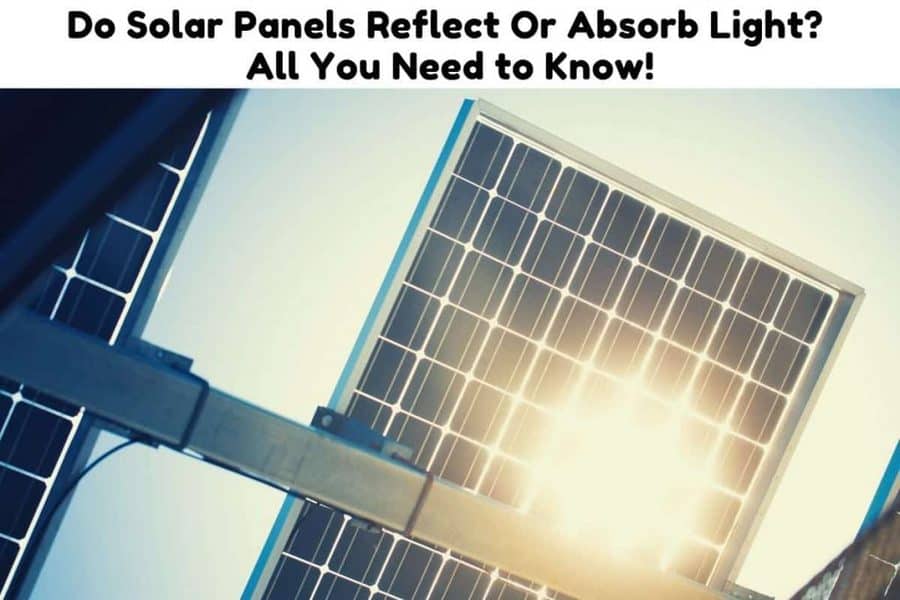Solar panels are designed to reduce the reflection of light. In a study investigating the effect of glare caused by solar panels on air pilots, the findings were that solar panels reflect less than 3% of light.
Solar panels have a special relationship with light. Most people, when new to solar, misunderstand the relationship between solar panels and the sun. It is a common misconception that photovoltaic solar panels generate energy from heat when in fact photovoltaic solar panels rely solely on light to produce electricity.
How does the relationship between light and solar panels play out? This is the question we will look at in this article. We will explore how much light is absorbed and used to create solar energy. Then we will look at what happens when you reflect light onto a solar panel before we finally look at how much light is lost through reflection.

How Do Solar Panels Convert Light Into Energy?
Solar panels work through a process known as the photovoltaic effect. In terms of this process, light from the sun or artificial light sources like LEDs and infrared light bulbs is converted into energy. (Source)
On a side note! If you’re in need of a reliable and high-performance portable solar panel, We strongly recommend the Jackery SolarSaga 100W Portable Solar Panel (Amazon Link).
With a high conversion efficiency and foldable design, this solar panel is easy to transport and set up, making it perfect for outdoor activities like camping, hiking, and RV trips.

The US solar cell technology used in this panel ensures that you get the most efficient and reliable solar charging possible.
There is also a 60W option that is more affordable (Amazon Link)
Photons are units of energy found in light. When photons are absorbed in a solar panel, they energize the electrons in the solar panel which ultimately leads to the flow of an electric current.
Naturally, the more light a solar panel can absorb, the more “raw material” there is from which to create energy. The more efficiently a solar panel can absorb the light without there being any “spillage” in the form of reflected light, the more efficient the solar panel will be.
How Much Light Do Solar Panels Absorb?
Solar panels absorb just over a third of the light they are exposed to. Light absorption is one of the crucial determinants of the efficiency of solar cells. It is one of the limiting factors on just how much energy solar cells can produce.
Millions of dollars worth of research have gone into finding ways of making solar panels that can absorb more light. There have been some breakthroughs with lab-tested solar panels that can absorb over 90% of light. (Source)
From what is absorbed by the solar panel, only 10 to 30% finally makes its way into an appliance as electricity. The rest is lost as heat. The conversion process of a solar cell is not 100% efficient. It should be said, however, that any process where energy is converted from one form to another is not completely efficient.
For more on solar panels’ relation to heat, check out our post “Do Solar Panels Absorb, Reflect, or Radiate Heat? What You Need To Know!“
Do Solar Panels Work with Reflected Light?
Solar panels will still convert light into energy even if it is through reflected light. Though a solar panel works best with direct light, it will still work even with reflected light from a reflective surface like water, a mirror, or even snow.
A solar panel will yield more energy when it is exposed to direct light. That means it should be positioned perpendicular to the light source without any shade or obstruction in between. But what happens when you reflect or bounce light to a solar panel? Will it produce any or as much energy?
Reflecting light on solar panels
You might wonder why you would want to reflect light onto a solar panel. The simplest reason would be to get more light, possibly at a time when the solar panel is in shade. While this is not the best way to get more out of a solar panel, it does work. Ideally, you should not be installing or placing a solar panel where it will fall into shade.
One popular way of reflecting light onto solar panels is through the use of mirrors. Large-scale solar projects use what is known as concentrated solar power to harness both heat and light through the use of mirrors.
Using mirrors boosts the output of the solar panel by up to 75%. The downside to this, which reduces its effectiveness, is that the sun moves. When it moves so too will the angle of reflection. Where a few minutes ago the solar panel was getting a full blast of light from the mirror, now it is not since the sun has changed its position.
This is why almost every concentrated solar power plant uses trackers that follow the sun as it moves. This ensures that the angle of reflection is spot on. While this is feasible for a large project at scale, this would get hugely expensive and complicated at the smaller scale of a residential solar system.
For more on this, we highly recommend that you check out our post ” Can You Use Mirrors To Redirect Sunlight? Why You Shouldn’t!“
How Do Solar Panels Reflect Light?
Solar panels are designed to maximize light absorption and have an anti-reflective coating (ARC) that minimizes reflection. The anti-reflective coating makes them less reflective than a large body of water, ordinary glass windows, and even soil. Glass windows for example reflect about 4% of light.
Since solar panels use light to produce energy, it would make sense to design them to capture as much light as possible. And that is exactly where anti-reflective coating comes in. Increasing how much light comes in by reducing reflection.
Do All Solar Panels Use Anti-Reflective Coating?
There are two main types of solar cell technologies used today. These are crystalline silicon and thin-film solar. Crystalline silicon solar cells are distinct from thin-film in that they use a different manufacturing process.
Crystalline silicon uses a wafer-based design while thin-film cells are made by depositing semiconducting films on a substrate like glass or metal. While these might be different technologies, they both have several characteristics in common. For one, they both use an anti-reflective coating.
Without anti-reflective coating, solar panels would be nowhere near as effective as they are. They would experience a drastic loss in efficiency because they would absorb much less light due to increased reflection. The reflection of solar cells without anti-reflective coating is as high as 30%. (Source)
Anti-reflective coating is what gives a solar panel its blue color. Without coating, solar cells have dull grey color. Anti-reflective coating is also used on other materials like windscreens and camera lenses for the same purpose.
Made either from silicon nitride or titanium oxide, you can change the color of a solar cell by varying the thickness of the anti-reflective coating. Solar panels with coating do not just have better light transmittance. They also have less glare which allows them to blend better with their surroundings.
